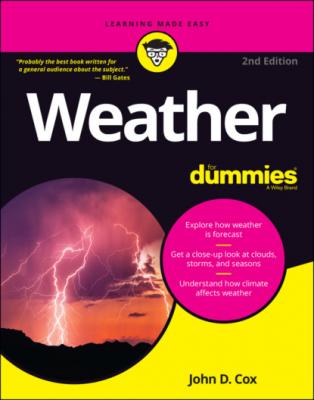Weather For Dummies. John D. Cox
Читать онлайн.| Название | Weather For Dummies |
|---|---|
| Автор произведения | John D. Cox |
| Жанр | |
| Серия | |
| Издательство | |
| Год выпуска | 0 |
| isbn | 9781119811022 |
Relative humidity on a warm day can make all the difference in how you feel. When the relative humidity of the 95-degree air is low, it is relatively easy for the body to cool itself. Perspiration seeps through the pores in the skin, and the moisture easily evaporates into the air. Heat energy burned up in changing the water from liquid to vapor leaves the body’s temperature cooler. When the relative humidity of the 95-degree air is high, however, it really doesn’t want to take up much more water vapor, thank you, so it is much harder for the body to get rid of its heat and its perspiration. So the heat builds up, the perspiration accumulates, and the poor body, well, it just kind of stews.
Heat index
The National Weather Service’s Heat Index, shown in Figure 2-1, shows apparent temperature values — the temperature that the body actually feels — which is more important than simply the heat or the humidity of the air. It is not just the heat or just the humidity, but both of these properties that this index combines to more accurately reflect what your body is going to have to cope with. The numbers in the index are based on shady, light wind conditions. Full sunshine exposure can raise these numbers by as much as 15 degrees Fahrenheit.
FIGURE 2-1: This Heat Index was devised by the National Weather Service to show the temperature the body feels when the heat and humidity are combined.
Between 80 degrees and 90 degrees on the Heat Index, be on the lookout for signs of fatigue with prolonged exposure or physical activity.
Between 90 degrees and 105 degrees, with prolonged exposure or physical activity, you may experience sunstroke, heat cramps, or heat exhaustion.
Between 105 degrees and 130 degrees, you are likely to experience sunstroke, heat cramps, or heat exhaustion.
At 130 degrees or above, dangerous conditions of heat stroke or sunstroke are highly likely with continued exposure.
FAHRENHEIT AND CELSIUS
The world of weather has two main ways of measuring the temperature of the air (and the temperature of water, for that matter). The Fahrenheit (F) scale is used in the United States; the Celsius (C) scale is used in much of the rest of the world, including Europe and Canada.
In 1714, German physicist Gabriel Daniel Fahrenheit developed a scale where water boils at 212 degrees (F) and freezes at 32 degrees (F).
In 1742, Swedish astronomer Anders Celsius devised a scale in which the melting point of ice is designated zero degrees (C), and the boiling point of water is 100 degrees (C).
This figure is a handy comparison of the two scales.
Wind
Winds have a lot to do with how storms come and go (Chapter 5 goes into detail), but the weather forecast concerns itself mainly with the wind in your face. A forecaster describes what is expected of the wind’s direction and its speed.
Wind direction describes where the wind is blowing from. And so a north wind is coming out of the north and blowing toward the south. You get the idea. Weather forecasts commonly describe the direction of winds on an eight-point compass: north, northeast, east, southeast, and so on.
Winds that blow only up to 5 miles per hour are generally described as light, or light and variable, to indicate that they are kind of wafting around in different directions. Winds 15 to 25 miles per hour sometimes are described as breezy when it’s mild weather or brisk when it’s cold. The word for 20 to 30 miles per hour is usually plain windy, at 30 to 40 miles per hour they are very windy, and winds blowing 40 miles per hour or greater can be described as strong, damaging, dangerous, or high. Winds become “hurricane force” at 74 miles per hour, but they are dangerous well before then. (Stay out of them!)
Wind chill
Wind can make hot temperatures feel cooler and cool temperatures feel colder. This is the wind chill factor — how a wind makes the body feel that the air around it is colder. Wind chill can be an important indicator of the danger of severe cold winter conditions.
The warmth of the body actually creates a thin envelope of warm air around it, a little insulating comfort zone. Along comes the wind that whisks that envelope away, exposing the skin to the raw cold and accelerating the heat lost by the body. The stiffer the wind, the greater the heat loss, the colder the feeling of air.
Sky cover
When the sky will be free of all cloudiness or less than one-tenth cloudy, forecasters describe it as clear or sunny.
At three-tenths to six-tenths, the sky is partly cloudy or partly sunny or scattered with clouds.
At seven-tenths to eight-tenths, the sky is mostly cloudy or cloudiness is broken.
At nine-tenths to the whole shebang, it’s just plain cloudy or overcast.
How to Read a Weather Map
Weather maps have been around for the better part of two centuries, and for much of that time, they were the only way to visualize a lot of what was going on — or what forecasters thought was going on — in the atmosphere. But even now, when satellite images of actual storms and fronts are available, often a television forecaster and a newspaper weather page will display a simplified weather map to make clear to viewers and readers what’s going on.
The typical stripped-down version of a weather map highlights a few features of the weather picture across the nation. As Figure 2-2 illustrates, centers of high pressure and low pressure are designated simply by a large
